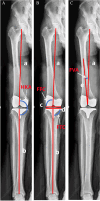Evaluating the accuracy of a new robotically assisted system in cadaveric total knee arthroplasty procedures
- PMID: 38879524
- PMCID: PMC11179344
- DOI: 10.1186/s13018-024-04788-8
Evaluating the accuracy of a new robotically assisted system in cadaveric total knee arthroplasty procedures
Abstract
Background: Robot-assisted total knee arthroplasty (TKA) has been shown to facilitate high-precision bone resection, which is an important goal in TKA. The aim of this cadaveric study was to analyze the accuracy of the target angle and bone resection thickness of a recently introduced robotic TKA system.
Methods: This study used 4 frozen cadaveric specimens (8 knees), 2 different implant designs, navigation, and a robotic system. The 4 surgeons who participated in this study were trained and familiar with the basic principles and operating procedures of this system. The angle of the bone cuts performed using the robotic system was compared with the target angles from the intraoperative plan. For each bone cut, the resection thickness was recorded and compared with the planned resection thickness.
Results: The mean angular difference for all specimens was less than 1°, and the standard deviation was less than 2°. The mean difference between the planned and measured angles was close to 0 and not significantly different from 0 except for the difference in the frontal tibial component angle, which was 0.88°. The mean difference in the hip-knee-ankle axis angle was - 0.21°± 1.06°. The mean bone resection difference for all specimens was less than 1 mm, and the standard deviation was less than 0.5 mm.
Conclusions: The results of the cadaveric experimental study showed that the new TKA system can realize highly accurate bone cuts and achieve planned angles and resection thicknesses. Despite the limitations of small sample sizes and large differences between cadaveric and clinical patients, the accuracy of cadaveric experiments provides strong support for subsequent clinical trials.
Keywords: Accuracy; Bone resection; Cadaveric study; ROPA TKA system; Robotic surgery; Total knee arthroplasty.
© 2024. The Author(s).
Conflict of interest statement
The authors have no relevant financial or non-financial interests to disclose.
Figures






References
Publication types
MeSH terms
Grants and funding
LinkOut - more resources
Full Text Sources
Medical

